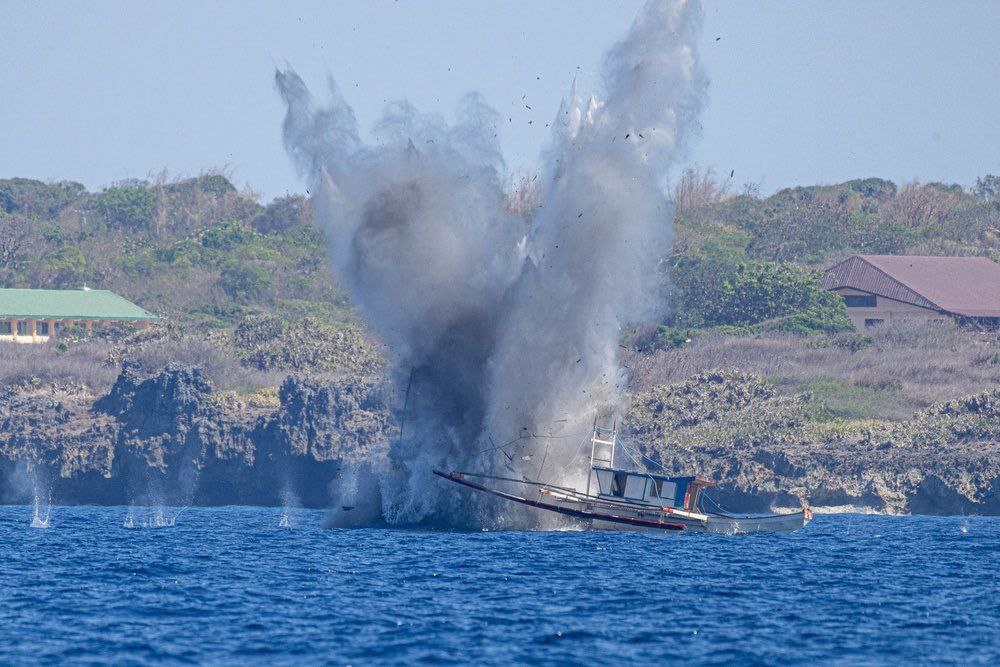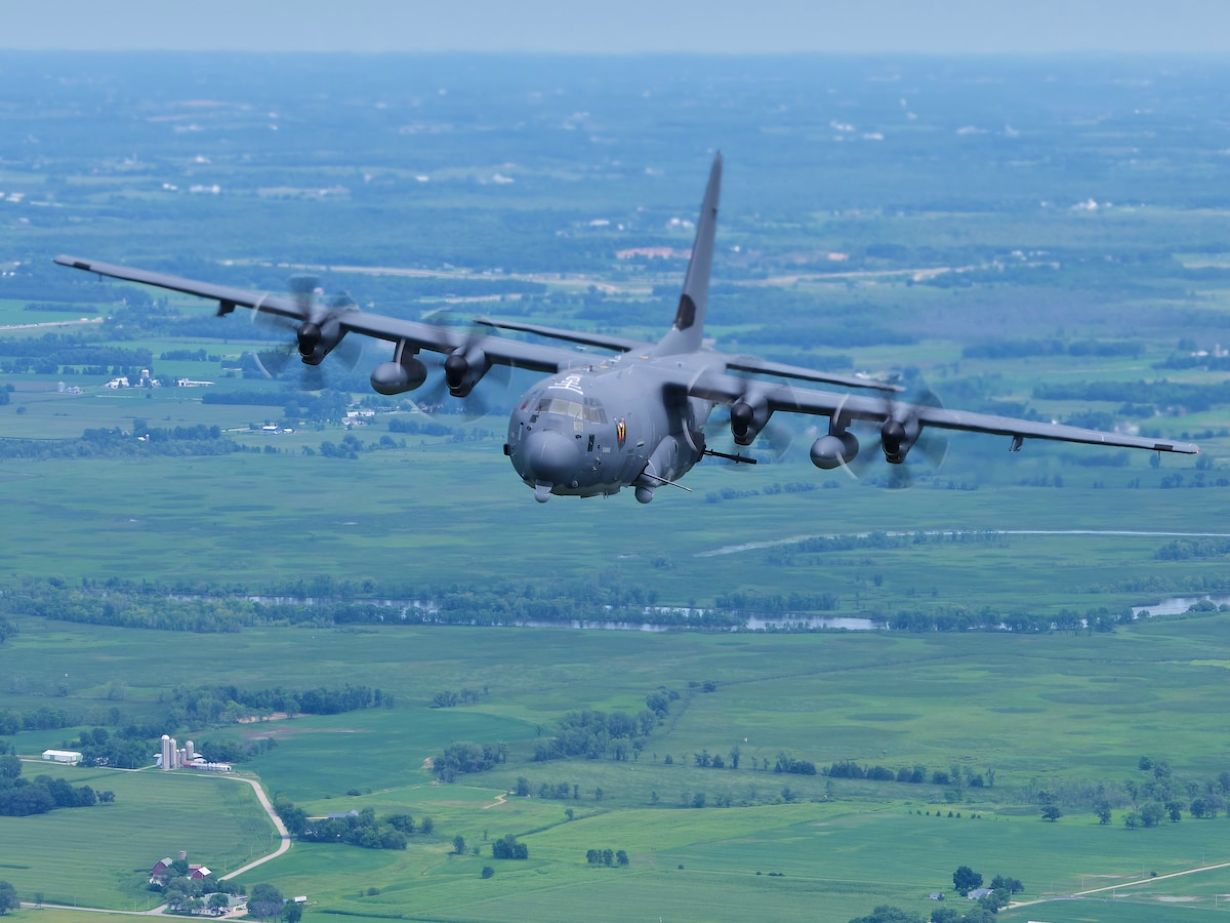The US used its legendary AC-130J Ghostrider gunship in an exercise that involved firing its left-side guns on targets simulating China’s notorious fishing boats. This was during Exercise Balikatan 24 with the Philippine military.
The AC-130J, used by the US Air Force Special Operations Command (AFSOC), is a unique plane with a 30-mm and a 105-mm cannon on its left (port-side) lower fuselage.
The plane circles overhead while providing direct fire support to ground troops. It can also carry air-to-ground weapons like the GBU-39 Small Diameter Bomb, GBU-69 Small Glide Munition, AGM-114 Hellfire missile, and AGM-176 Griffin missile.
The aircraft is a C-130 Hercules transport plane. The plane’s target of a small fishing boat, too, assumes significance since China’s use of large swarms of fishing vessels to assert its maritime rights has often vexed military experts.
This was a rare occasion when a military drill addressed the issue of fishing vessels.
A video released by the US military showed shots repeatedly striking the surface of the water and an explosion taking place. This suggests that the fire was coming from overhead and that a small sea-going vessel was being struck. While the boat itself was not seen, a structure that appeared to be a mast was seen sinking. The video concluded by showing the AC-130J flying overhead.
The US military statement described the Ghostrider, assigned to the 27th Special Operations Wing, engaging “a target vessel during a maritime littoral strike.” Other pictures released on social media showed the boat’s bridge.

China’s Dual-Use Fishing Boats
Experts have long observed how China’s fishing vessels are used as an extension of its politico-strategic goals when it aims to assert its maritime rights/claims without resorting to military means. Simply put, it is an extension of its ‘gray zone’ doctrine.
Open source literature says that the ‘maritime militia’ is essentially a sea border management and enforcement arm, asserting China’s oceanic rights and claims. It does have a secondary warfighting role, where it does not directly take part in hostilities but undertakes surveillance, reconnaissance, and logistical roles.
Based on papers published by the RAND Corporation’s Center for Strategic and International Studies (CSIS) and official US military forums, it does not appear that the boats may be armed with missiles or weapons. Experts, however, believe China might decide to arm them if necessary.
Shuxian Luo and Jonathan G. Panter tracked the evolution of China’s fishing fleet and its place in the overall military-strategic scheme of things in a study published on the US Army University Press website. In its 2000 defense white paper, China described the maritime militia as a “joint military-civilian land and sea border management system, headed by the military and with a sharing of responsibilities between the military and the civilian authorities.”
Since then, China has gradually transitioned from a relatively naval-intensive approach towards a “multiagent, division-of-labor method” in managing its maritime borders. Since 2005, China has preferred to employ the PLA Navy (PLAN) in background roles, relying instead on maritime law enforcement agencies and the maritime militia “as its frontline responses to contingencies”.

The fishing boats appear to have more military-logistical value than core combat utility. The Chinese describe them as “an armed mass organization composed of civilians retaining their regular jobs,” a component of China’s armed forces, and an “auxiliary and reserve force” of the PLA. The militia assists the PLA “by performing security and logistics functions in war.”
This can involve supplying frontline warships on the high seas with ammunition or rations and taking a load off other vessels in the PLAN fleet meant for the task. Whether PLAN and the militia exercised together for this purpose is not known. However, it still “receives training from both the PLAN (People’s Liberation Army Navy) and CCG (China Coast Guard (CCG),” despite being separate from them.
This is to “perform tasks including — but not limited to border patrol — surveillance and reconnaissance, maritime transportation, search and rescue, and auxiliary tasks in support of naval operations in wartime,” said the report.
Past Employment
An April 2020 article by defense analyst Derek J. Grossman for the RAND Corporation said the People’s Armed Forces Maritime Militia (PAFMM) established “a de facto Chinese operating presence in disputed areas – in effect, changing the facts on the ground, or at sea” – to challenge the opposing party’s territorial claims.
These classic “gray zone” operations are designed to “win without fighting” by overwhelming the adversary with swarms of fishing vessels, usually bolstered from the rear with CCG and possibly PLAN warships. In January 1974, during the Paracel Islands dispute with South Vietnam, PAFMM forces demonstrated their contribution to the islands’ seizure campaigns.
“The presence of Chinese fishing vessels around the Paracels slowed South Vietnamese decision-making on using force against PAFMM and their response times to counter PLAN maneuvers. The additional time they were allowed Beijing to coordinate more effectively.
When two fishing trawlers delivered 500 PLA troops to the Western Paracels, it resulted in the immediate surrender of the South Vietnamese soldiers there,” said the article.
In 1978, they swarmed the Senkaku/Diaoyu islands, which were disputed by Japan, ramping up their presence there in 2016. They were also involved in the PRC seizing Mischief Reef and Scarborough Shoal from the Philippines in 1995 and 2012, respectively.
Beijing also attempted to blockade Manila’s resupply to the Second Thomas Shoal in 2014, and since 2017, has harassed Filipino fishermen at Sandy Cay and nearby Thitu (Pagasa) Island.
How Will the AC-130 Help
The cheap mass-manufactured fishing vessels can pose an asymmetric threat to warships. Experts differ on whether the boats may be armed with direct offensive weapons like missiles or laying mines. They, however, agree that the boats have non-combat support roles like carrying surveillance, reconnaissance, Electronic Intelligence (ELINT) equipment, high-powered jam-resistant communication devices, and, in the future, employ drones, too.
This makes targeting all fishing vessels as hostiles impossible. A naval warship commander may not necessarily be able to determine what a boat might be up to, especially when it is not engaging in typically hostile maneuvers.
An AC-130, circling above with possibly other assets like a naval helicopter, can look at the boat’s movements from a higher altitude, allowing warships to anticipate some disruptions when fishing boats are spotted.
Upon visual confirmation of the fishing boats’ engagement in combat support activity, the AC-130 can open fire. If not, it can fire a warning shot around the waters to dissuade these boats from continuing their mission.
This is subject to irrefutable verification that the boats are in active combat roles. However, given how China is less likely to arm the PAFMM with lethal weapons to prevent all of them from being considered legitimate targets, it reduces the scope for the AC-130’s use.
- The author can be reached at satamp@gmail.com
- Follow EurAsian Times on Google News




